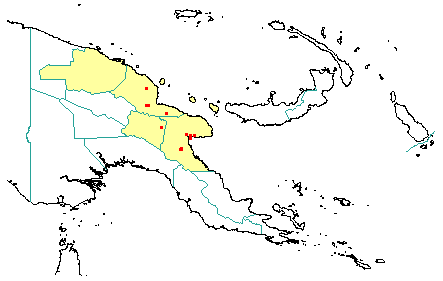
in PNGplants database
PNGTreesKey – Hibiscus papuodendron Kosterm. |
Barry Conn (NSW) & Kipiro Damas (LAE).
Guide to trees of Papua New Guinea
Copyright held by the authors, National Herbarium of New South Wales, and Papua New Guinea National Herbarium
Reinwardtia Vol. 5: 325 (1960)
Family: Malvaceae
Dicotyledon
Timber Group: Minor hardwood
Field Characters: Large canopy tree (up to 30 m high, rarely to 40 m) or Small sub-canopy tree; Bole cylindrical (to slightly irregular, up to 1 m diam., less frequently to 1.5 m); crooked or straight (bole 10-20 m long); buttresses buttresses present; spines spines absent; aerial roots aerial roots absent; stilt roots stilt roots absent; Bark greenish grey or brown, rough, fissured or slightly pustular, lenticels elongated vertically; Subrhytidome (under-bark) yellow, green, or mottled; less than 25 mm thick; bark blaze slightly with two layers; faintly to non-aromatic; outer blaze white or pale yellow, markings absent, fibrous; inner blaze white (yellowish (straw-coloured), markings absent, fibrous; bark exudate (sap) present, colourless, flowing, colour not changing on exposure to air, not sticky; terminal buds not enclosed by leaves.
Indumentum: Complex hairs present, disk-shaped (peltate) (dense); stinging hairs absent; mature twig indumentum (hairs) absent.
Leaves: Leaves spaced along branches, spiral (leaves occurring singly at a node and arranged spirally up the branchlet), simple (a leaf composed of a single blade) (smelling like raw cabbage when crushed); petiole present, not winged, attached to base of leaf blade, not swollen; leaves broadest at or near middle or equally broad throughout much of length, 9.0-12.0 cm, 4.0-6.0 cm; symmetric (slightly cordate), entire, not dissected or lobed, obtuse or sub acute, venation pinnate or at base palmate, secondary veins open, prominent, intramarginal veins absent; leaves lower surface green or yellow (rough to touch), upper surface dark green (dull (sometimes grey-green), indumentum (hairs) absent (but densely covered with peltate scales); absent; domatia present, scattered along midrib; stipules present, free, laterally placed, not encircling the twig, leafy, not fringed, large, not persistent.
Flowers: Inflorescence terminal or axillary (in distal axils), flowers on a branched axis, cones absent; flowers bisexual, stalked, flowers with many planes of symmetry, 20.0-30.0 mm long, diameter large (more than10 mm diam.) (20-30 mm diam.); perianth present, with distinct sepals and petals whorls (with sepals 5-lobed), inner perianth white or at base purple; 5, free; stamens 100, present (of varing lengths), joined (forming a staminal tube around the style), free of the perianth; ovary superior, carpels joined (when more than one), locules 5; styles solitary, 1.
Fruits: Infrutescence arranged on branched axis, fruit 15.0 (c.) mm long, brown (pale (slightly straw-coloured), not spiny, non-fleshy, simple, dehiscent, capsule; seeds 100.
Distribution: East Sepik, Madang, Morobe & Eastern Highlands.
 | Botanical records in PNGplants database |